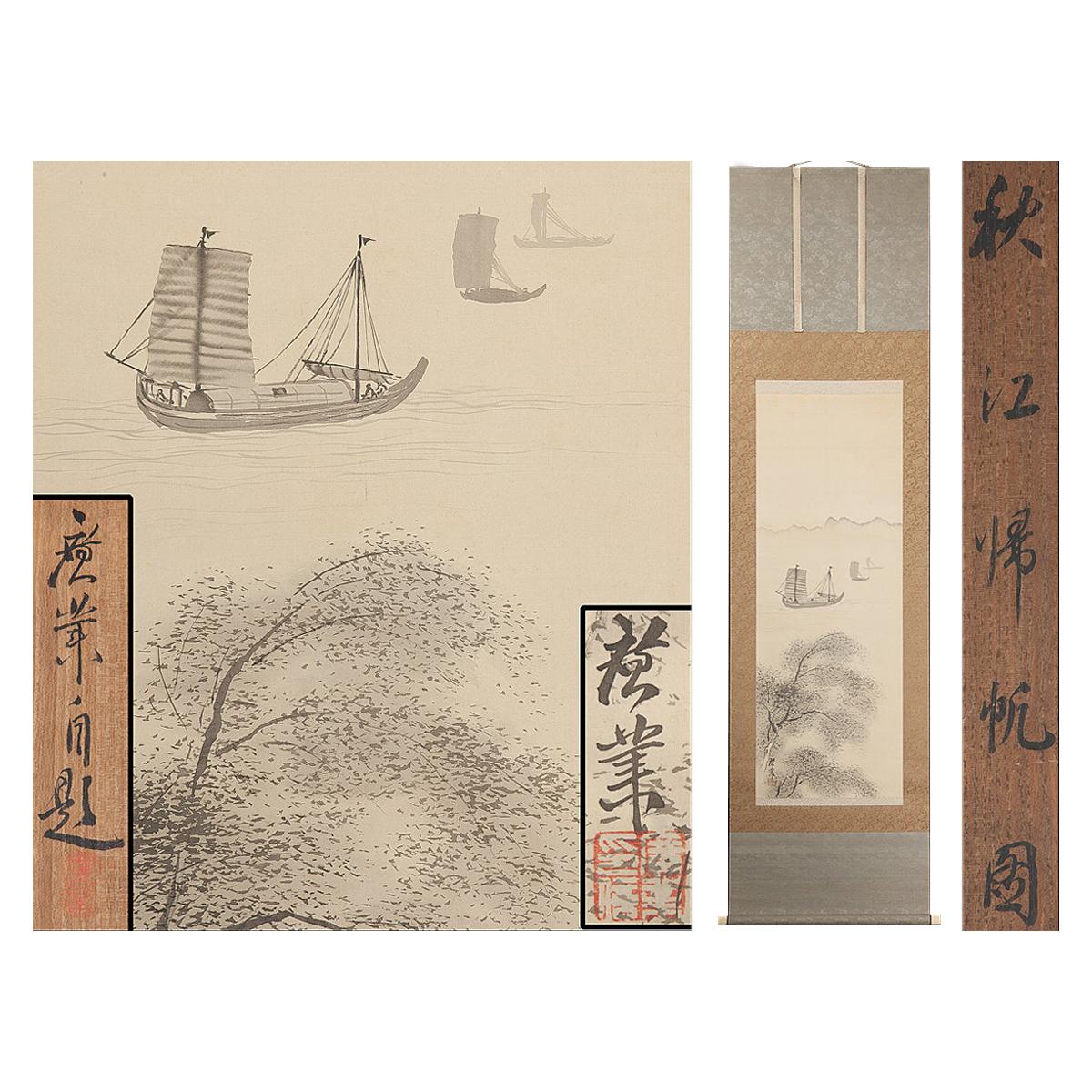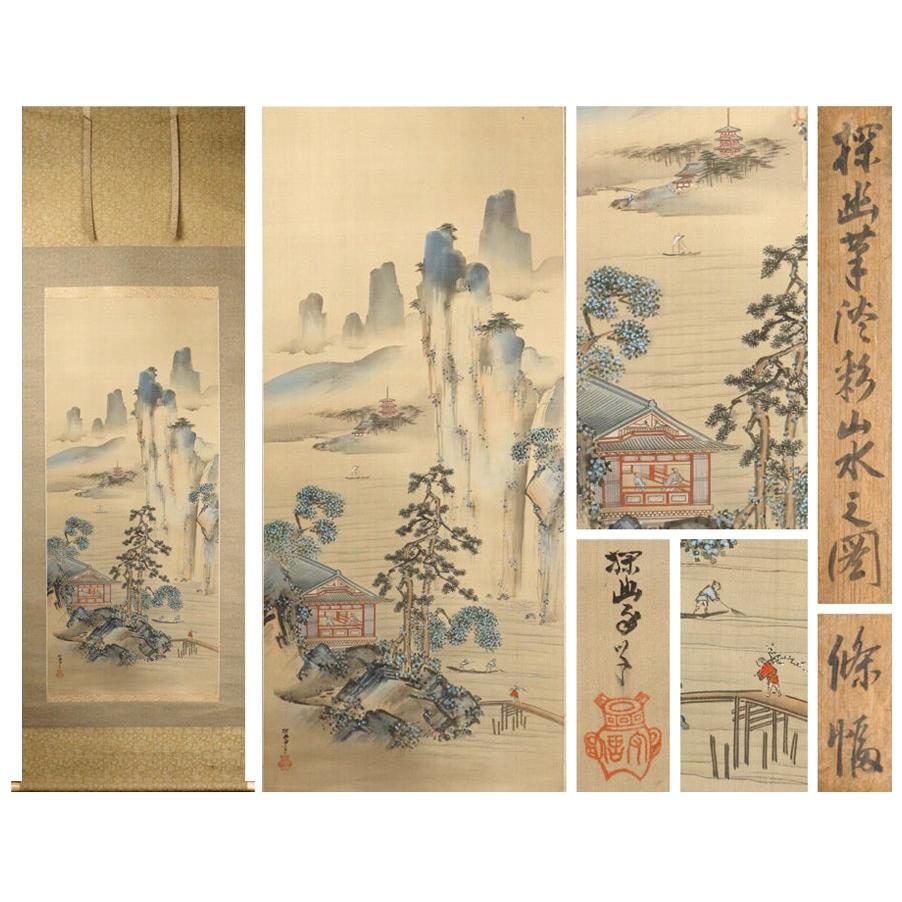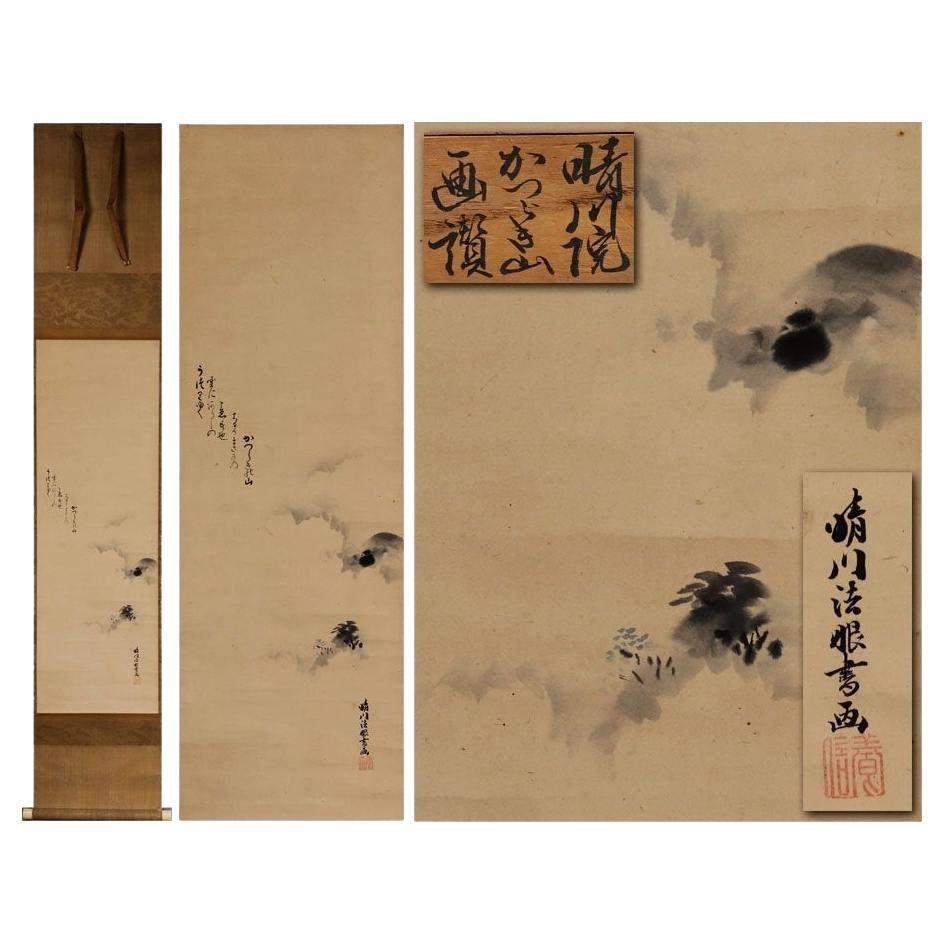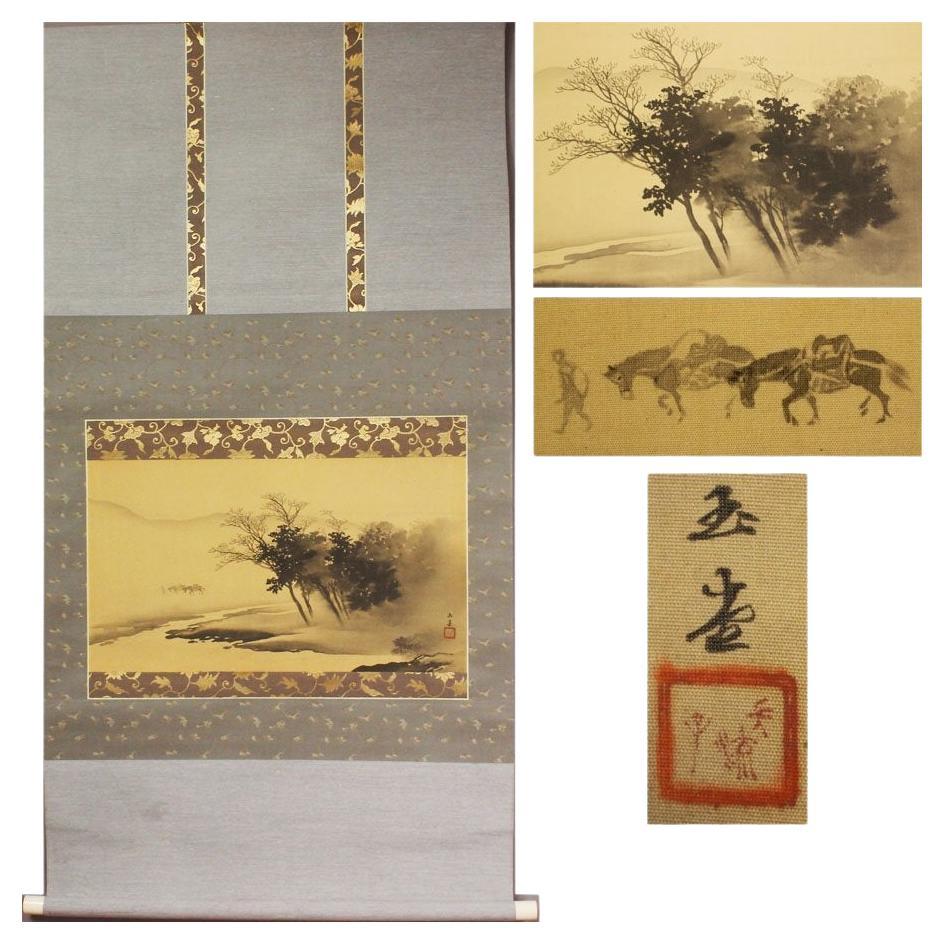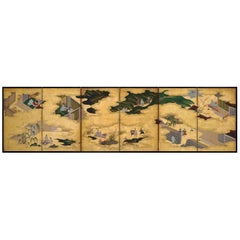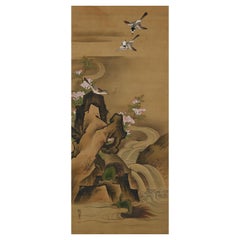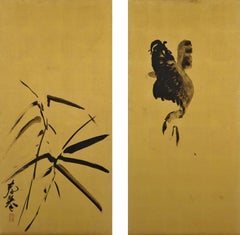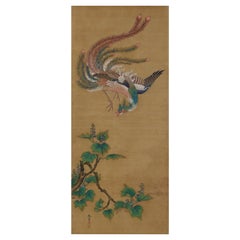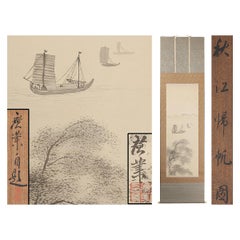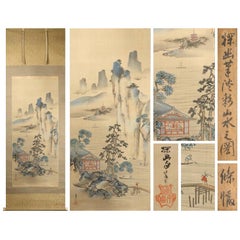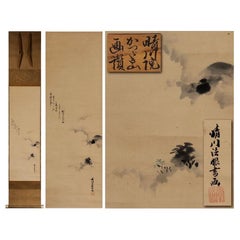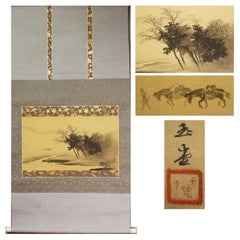Items Similar to Japanese Painting, Hanging Scroll, Mid 19th Century, Koi and Water Plants
Want more images or videos?
Request additional images or videos from the seller
1 of 5
Japanese Painting, Hanging Scroll, Mid 19th Century, Koi and Water Plants
$6,500
£4,969.60
€5,723.97
CA$9,108.49
A$10,168.78
CHF 5,328.29
MX$124,475.80
NOK 67,669.28
SEK 63,803.54
DKK 42,718.58
Shipping
Retrieving quote...The 1stDibs Promise:
Authenticity Guarantee,
Money-Back Guarantee,
24-Hour Cancellation
About the Item
Iwase Hirotaka (1808-1877)
Koi and Water Plants
Hanging scroll, ink, color, gold wash and gold flecks on silk
Inscription: Hirotaka
Seal: Illegible
Dimensions:
Scroll: 144 cm x 54.5 cm (56.5" x 21.5")
Image: 59 cm x 43.5 cm (23" x 17")
This vivid depiction of two koi or carp among water plants dates to the mid-19th century. The artist, Iwase Hirotaka, has distorted and exaggerated the facial characteristics of the fish in a method that resembles the art of caricature, adding a humorous and charming touch to a familiar subject. Painted on silk with ink, colors and gold-wash, the scene is enhanced with layered flecks of gold, which act to obscure our view and increase the intimacy of the scene. Unlike the koi paintings of the Maruyama-Shijo school of art, which are painted with a dedication to naturalism, and the somewhat repetitive koi imagery of the long-standing Kano school, the artist here appears to have taken inspiration from the work of Ito Jakuchu, who himself was known to reference Korean paintings for models.
Iwase Hirotaka (1808-1877) was originally a Kyoto based Ukiyo-e artist known as Hishikawa Kiyoharu. At the age of 26 or 27 he moved to Wakayama, changed his name, and began studying Yamato-e with Tanaka Totsugen and Ukita Ikkei. Totsugen and Ikkei were leaders of the Fukko Yamato-e school, and closely connected to a political movement which sought to Revive the power of the Emperor. A diverse and accomplished artist, Iwase Hirotaka eventually turned to literati painting, which he learned from Tetsuo Somon.
- Creator:Iwase Hirotaka (Artist)
- Dimensions:Height: 56.5 in (143.51 cm)Width: 21.5 in (54.61 cm)Depth: 0.75 in (1.91 cm)
- Style:Edo (Of the Period)
- Materials and Techniques:
- Place of Origin:
- Period:
- Date of Manufacture:circa 1860
- Condition:Refinished. Wear consistent with age and use. Conservation and full re-mounting undertaken in Kyoto utilizing traditional techniques and craftsmen.
- Seller Location:Kyoto, JP
- Reference Number:1stDibs: LU2472313833961
About the Seller
5.0
Recognized Seller
These prestigious sellers are industry leaders and represent the highest echelon for item quality and design.
Established in 2001
1stDibs seller since 2016
70 sales on 1stDibs
Typical response time: 6 hours
- ShippingRetrieving quote...Shipping from: Kyoto, Japan
- Return Policy
Authenticity Guarantee
In the unlikely event there’s an issue with an item’s authenticity, contact us within 1 year for a full refund. DetailsMoney-Back Guarantee
If your item is not as described, is damaged in transit, or does not arrive, contact us within 7 days for a full refund. Details24-Hour Cancellation
You have a 24-hour grace period in which to reconsider your purchase, with no questions asked.Vetted Professional Sellers
Our world-class sellers must adhere to strict standards for service and quality, maintaining the integrity of our listings.Price-Match Guarantee
If you find that a seller listed the same item for a lower price elsewhere, we’ll match it.Trusted Global Delivery
Our best-in-class carrier network provides specialized shipping options worldwide, including custom delivery.More From This Seller
View AllJapanese Screen Painting, Circa 1700 'Tales of Ise' by Tosa Mitsusuke
By Tosa Mitsusuke 1
Located in Kyoto, JP
A six-fold Japanese screen by Tosa Mitsusuke (1675-1710), Japan 17th-18th century, Edo period.
The signature reads Shoroku-i ge Tosa sa Konoe Shogen Mit...
Category
Antique Late 17th Century Japanese Edo Paintings and Screens
Materials
Gold Leaf
19th Century Japanese Silk Painting by Kano Chikanobu, Turtles & Azalea
Located in Kyoto, JP
Birds & flowers of the seasons
Pheasants & plum in snow
Unframed painting. Ink, pigment and gofun on silk
Kano Chikanobu 1819-1888
Signature...
Category
Antique Mid-19th Century Asian Edo Paintings and Screens
Materials
Silk
Yamamoto Shunkyo (1871-1933) Japanese Framed Painting Pair, Carp and Bamboo
Located in Kyoto, JP
Two framed panels by Yamamoto Shunkyo depicting a carp (koi) leaping from a river.
Ink and gold leaf on paper.
Instinctively brushed in a freehand s...
Category
Early 20th Century Japanese Meiji Paintings and Screens
Materials
Gold Leaf
19th Century Japanese Silk Painting by Kano Chikanobu, Phoenix & Paulownia
Located in Kyoto, JP
Birds & Flowers of the seasons
Pheasants & Plum in Snow
Unframed painting. Ink, pigment and gofun on silk
Kano Chikanobu 1819-1888
Signature...
Category
Antique Mid-19th Century Asian Edo Paintings and Screens
Materials
Silk
Japanese Painting, Hanging Scroll, 19th Century Bamboo in Moonlight
Located in Kyoto, JP
Bamboo in moonlight
Gamo Rakan (1784-1866)
Hanging scroll, ink on silk.
Dimensions:
Scroll: 201 cm x 58 cm
Image: 137 cm x 45 cm
In this early 19th century work by Gamo Rakan a light ink wash applied to the silk background silhouettes the moon and suggests the atmosphere of early evening. Even though it is a literati subject, Rakan’s bamboo is quite realistic with a strong decorative style. The painting finds its inspiration from Chinese Ming dynasty painters who often used a single-tone, jet black stroke to emphasize the calligraphic nature of bamboo.
In a different era, decorative would have been seen as somewhat unrefined. But increasingly in the Edo period, it was the hallmark of high style. The Japanese people, in particular the rising merchant class, had gradually become apathetic toward the traditional Sesshu and Kano schools of painting. Chinese professional and amateur painters living in the port of Nagasaki during the 18th century had a profound effect on Japanese painting and the freshness of their style and its decorative appeal contributed greatly to its popularity. Gamo Rakan’s teacher, Tani Buncho...
Category
Antique Early 19th Century Japanese Edo Paintings and Screens
Materials
Silk
19th Century Japanese Screen Pair. Flowers & Birds of the Four Seasons
Located in Kyoto, JP
Flowers & Birds of the Four Seasons
Pair of six-fold Japanese Screens. Ink, color, gofun and gold on paper.
Second half of the 19th Centur...
Category
Antique Late 19th Century Japanese Meiji Paintings and Screens
Materials
Wood, Paper
You May Also Like
Scroll Painting Japanese 19th-20th Century Kōgyō Terasaki Meiji
Located in Amsterdam, Noord Holland
A fabulous landscape by Kogyo Terasaki
1866-1919
Japan painter. Akita prefecture production. Character is Tokusato, Soyama-Agaryunoki, beautiful poetry Yamabito, etc. to another is...
Category
20th Century Japanese Meiji Paintings and Screens
Materials
Bronze
$1,240 Sale Price
25% Off
Lovely 17th-18th Century Scroll Painting Japan Artist Kano Soyu Painted
Located in Amsterdam, Noord Holland
It is a work that is said to have been drawn by Kano Soyu as you can see.
It is a picture of the light-colored Sansui map carefully drawn to the smallest detail, and the
towering m...
Category
Antique 17th Century Japanese Edo Paintings and Screens
Materials
Silk
$2,977 Sale Price
20% Off
Lovely Japanese 18/19th c Edo Scroll Kano Osanobu Nihonga Painting Mountain
Located in Amsterdam, Noord Holland
Kano Osanobu (狩野養信)
Osanobu Kano (born August 18, 1796; died June 12, 1846) was the ninth painter of the Kobikicho Kano School in the Edo period. His common name was Shozaburo. His father was Naganobu KANO, and Tadanobu KANO was his son. His Go (pen name) was Osanobu Seisenin, Kaishinsai, and Gyokusen.
Brief Personal History
He was born the eldest son of Naganobu ISENIN during the Edo period. He was first sent to serve at Edo Castle at the age of 15, and it appears that he was apparently pushed by his father to perform various public tasks for the Kanon School. He kept a diary for 36 years, starting from the day before he first went into service at Edo Castle until the day before he died. The diary is entitles "Official Service Diary" (it consists of 52 volumes that are maintained at the Tokyo National Museum, and 4 volumes that are separately maintained at the different families), and have become the focus of a lot of attention in recent years for the detailed information they present on the daily life and work of a prestigious official painter. The reading of the characters of his name was originally "Takenobu"; however, with the birth of the first son of the Shongun Ieyoshi TOKUGAWA in 1813, whose name was Takechiyo, having a sylable with the same pronunciation of "Take"was deemed to be inappropriate, and was therefore changed to "Osanobu". Because Takenobu died the following year, after which he was referred to as Gyokujuin, Osanobu changed his pen name Gyokusen he had used until that point to Seisenin, in order to avoid using the same Chinese charcter pronounced alike. In 1819, he attained the second highest rank for a Buddhist priest, Hogen, and assumed the role of head of the family after his father passed away in 1828. In 1834 he attained the highest rank for a Buddhist priest, Hoin. He oversaw the rennovation of the wall paintings of Nishinomaru Palace of Edo Castle from 1838 to 1839, and Honmaru Palace of it from 1844 to 1846. It is thought that Osanobu later died due to the fatigue...
Category
Antique 18th Century Edo Paintings
Materials
Silk
$1,699 Sale Price
20% Off
Nihonga Japanese Painting 1900 Meiji Scroll Kawai Gyokudo Nanga School Lake Scen
Located in Amsterdam, Noord Holland
This painting by Gyokudo Kawa is named "Lakeside Night Return", portraying a serene journey home.
Gyokudo Kawai
(1873-1957)
A Japanese painter from the Meiji to Showa periods, born ...
Category
Antique 19th Century Meiji Paintings
Materials
Silk
$2,268 Sale Price
20% Off
Japanese Edo Period Painting Scroll Ônishi Chinnen '1792 - 1851' Artist Signed
Located in Amsterdam, Noord Holland
Ônishi Chinnen (1792 - 1851) Schilpadden en bamboo
Rolschildering / scroll op papier, benen rollers. B 125.7 x 48.9 / 179.5 x 59.5 cm
125.7 x 48.9 / 179.5 x 59.5 cm.
Category
Antique Mid-19th Century Japanese Meiji Paintings and Screens
Materials
Silk
$1,465 Sale Price
20% Off
Japanese Meiji Riverside Scroll Painting, c. 1900
Located in Chicago, IL
Although western painting was initially embraced during Japan’s Meiji period (1868-1912), artists brought on a revival of traditional painting styles as they sought to create a modern Japanese style with roots in the past. This exquisite hanging scroll demonstrates the preference for soft layering of gray tones with judicious use of color. The landscape is rendered in soft ink washes that subtly distinguish between water, mountain, and sky. The scroll painting...
Category
Early 20th Century Japanese Meiji Paintings and Screens
Materials
Paper
More Ways To Browse
Midcentury Japanese Art
Antique Japanese Painting
19th Century Japanese Paintings
Watered Silk
Hanging Scrolls
Antique Japanese Scrolls
Hanging Screen
Emperor Japan
Ink Scroll
Asian Silk Paintings Antique
Japanese Scroll Art
Japanese Silk Paintings
Japanese Hand Scroll
19th Century Japanese Scroll
Scroll Painting Silk
Japanese Scrolls Painting
Silk Japanese Scrolls
Japanese Painting Silk Gold
